Remote Sensing-Based Analysis of Precipitation Events: Spatiotemporal Characterization across China
Abstract
1. Introduction
2. Methodology
2.1. Identify the Precipitation Objects at Each Time Interval
2.2. Identify the Same Precipitation Event through Time Intervals
- (i)
- If one object in the current (t) time interval only overlaps with one object in the previous (t − 1) time interval, the two objects are identified as the same precipitation event.
- (ii)
- If two or more objects in the current (t) time interval overlap with one object in the previous (t − 1) time interval, these objects are identified as the same precipitation event.
- (iii)
- If one object in the current (t) time interval overlaps with two or more objects belonging to different events in the previous (t − 1) time interval, the object is assigned to the object that has the largest overlap area, i.e., these two objects are identified as the same precipitation event.
3. Study Region and Data
3.1. Study Region
3.2. Precipitation Data
4. Results and Discussions
4.1. The Spatial Characteristics of Precipitation Events
4.2. The Relationships of the Different Characteristics of Precipitation Events
4.3. The Duration Characteristics of Precipitation Events
5. Conclusions
- (i)
- Precipitation events can be detected and identified in time and space scales based on the FiT algorithm and the gridded hourly precipitation product. It is a useful framework for characterizing precipitation events and understanding the relationships between the different characteristics of precipitation events.
- (ii)
- The spatial distribution of precipitation event characteristics (including the average precipitation totals and events per year, and the average totals, duration, maximum intensity, and intensity per event) notably differs across different climate zones. It decreases gradually from the southern (eastern) coastal regions to northern (western) inland areas of China.
- (iii)
- The event precipitation totals are generally more strongly correlated with event duration and event maximum intensity than with event intensity. The Pearson correlation coefficients of the event duration and event maximum intensity often exceed 0.7. The Pearson correlation coefficients between event maximum intensity and event intensity are higher in the climate zones with lower precipitation than climate zones with higher precipitation.
- (iv)
- The durations of precipitation events are generally shorter than 6 h, and the proportion of events having a duration shorter than 6 h generally exceeds 90%. The combined proportion of 1 h, 2–3 h, and 4–6 h is close to 100% in the PM and TC climate zones, and the frequency of heavy precipitation events is generally less than four per year. The proportion of events with a duration longer than 7 h generally exceeds 4% in ST and TM climate zones, and the frequency of heavy precipitation events is often more than seven per year.
Author Contributions
Funding
Data Availability Statement
Acknowledgments
Conflicts of Interest
References
- He, H.; Wang, J.; Ding, J.; Wang, L. Spatial Downscaling of Precipitation Data in Arid Regions Based on the XGBoost-MGWR Model: A Case Study of the Turpan–Hami Region. Land 2024, 13, 448. [Google Scholar] [CrossRef]
- Bevacqua, E.; Zappa, G.; Lehner, F.; Zscheischler, J. Precipitation trends determine future occurrences of compound hot–dry events. Nat. Clim. Chang. 2022, 12, 350–355. [Google Scholar] [CrossRef]
- Zhu, Z.; Cai, Y.; Dai, X.; Bai, X.; Yang, Y.; Li, X.; Yang, Z. Spatiotemporally contiguous precipitation events across China: Role of atmospheric rivers and tropical cyclones in heavy precipitation. Ecol. Indic. 2024, 158, 111426. [Google Scholar] [CrossRef]
- So, B.-J.; Kim, H.-S.; Kwon, H.-H. Spatial pattern of bias in areal rainfall estimations and its impact on hydrological modeling: A comparative analysis of estimating areal rainfall based on radar and weather station networks in South Korea. Stoch. Environ. Res. Risk Assess. 2024, 38, 1–17. [Google Scholar] [CrossRef]
- Ballarin, A.S.; Wendland, E.; Zaerpour, M.; Hatami, S.; Neto, A.A.M.; Papalexiou, S.M. Frequency Rather Than Intensity Drives Projected Changes of Rainfall Events in Brazil. Earth’s Future 2024, 12, e2023EF004053. [Google Scholar] [CrossRef]
- Wang, X.; Jiang, W.; Wu, J.; Hou, P.; Dai, Z.; Rao, P.; Ling, Z.; Deng, Y. Extreme hourly precipitation characteristics of Mainland China from 1980 to 2019. Int. J. Climatol. 2023, 43, 2989–3004. [Google Scholar] [CrossRef]
- Burn, D.H.; Whitfield, P.H. Climate related changes to flood regimes show an increasing rainfall influence. J. Hydrol. 2023, 617, 129075. [Google Scholar] [CrossRef]
- Eini, M.R.; Rahmati, A.; Salmani, H.; Brocca, L.; Piniewski, M. Detecting characteristics of extreme precipitation events using regional and satellite-based precipitation gridded datasets over a region in Central Europe. Sci. Total. Environ. 2022, 852, 158497. [Google Scholar] [CrossRef] [PubMed]
- Wang, X.; Luo, M.; Wu, S.; Ning, G.; Liu, Z.; Wang, S.; Wang, P.; Zhang, H.; Li, X. Spatiotemporal Evolution Patterns of Contiguous Extreme Precipitation Events Across China From a 3D Perspective. Geophys. Res. Lett. 2022, 49, e2022GL098840. [Google Scholar] [CrossRef]
- Mondal, S.; Mishra, A.K.; Leung, L.R. Spatiotemporal Characteristics and Propagation of Summer Extreme Precipitation Events Over United States: A Complex Network Analysis. Geophys. Res. Lett. 2020, 47, e2020GL088185. [Google Scholar] [CrossRef]
- Wang, H.; Liu, J.; Klaar, M.; Chen, A.; Gudmundsson, L.; Holden, J. Anthropogenic climate change has influenced global river flow seasonality. Science 2024, 383, 1009–1014. [Google Scholar] [CrossRef] [PubMed]
- Trenberth, K.E.; Dai, A.; Rasmussen, R.M.; Parsons, D.B. The Changing Character of Precipitation. Bull. Am. Meteorol. Soc. 2003, 84, 1205–1218. [Google Scholar] [CrossRef]
- Christidis, N.; Stott, P.A. Human Influence on Seasonal Precipitation in Europe. J. Clim. 2022, 35, 5215–5231. [Google Scholar] [CrossRef]
- Armon, M.; Marra, F.; Enzel, Y.; Rostkier-Edelstein, D.; Garfinkel, C.I.; Adam, O.; Dayan, U.; Morin, E. Reduced Rainfall in Future Heavy Precipitation Events Related to Contracted Rain Area Despite Increased Rain Rate. Earth’s Future 2021, 10, e2021EF002397. [Google Scholar] [CrossRef]
- Sun, S.; Shi, P.; Zhang, Q.; Wang, J.; Wu, J.; Chen, D. Evolution of future precipitation extremes: Viewpoint of climate change classification. Int. J. Climatol. 2021, 42, 1220–1230. [Google Scholar] [CrossRef]
- Yu, X.; Gu, X.; Kong, D.; Zhang, Q.; Cao, Q.; Slater, L.J.; Ren, G.; Luo, M.; Li, J.; Liu, J.; et al. Asymmetrical Shift Toward Less Light and More Heavy Precipitation in an Urban Agglomeration of East China: Intensification by Urbanization. Geophys. Res. Lett. 2022, 49, e2021GL097046. [Google Scholar] [CrossRef]
- Wei, L.; Gu, X.; Slater, L.J.; Lai, Y.; Kong, D.; Liu, J.; Li, J.; Zhang, X. Heavier Precipitation in Response to Longer-Lasting Tropical Cyclones and Rapid Urbanization over the Yangtze River Delta of Eastern China. J. Clim. 2024, 37, 403–418. [Google Scholar] [CrossRef]
- Gao, L.; Huang, J.; Chen, X.; Chen, Y.; Liu, M. Contributions of natural climate changes and human activities to the trend of extreme precipitation. Atmos. Res. 2018, 205, 60–69. [Google Scholar]
- Thackeray, C.W.; Hall, A.; Norris, J.; Chen, D. Constraining the increased frequency of global precipitation extremes under warming. Nat. Clim. Chang. 2022, 12, 441–448. [Google Scholar] [CrossRef]
- Gu, G.; Adler, R.F. Observed variability and trends in global precipitation during 1979–2020. Clim. Dyn. 2023, 61, 131–150. [Google Scholar] [CrossRef]
- Swain, S.S.; Kumar, S.B.; Mishra, A.; Chatterjee, C. Sensitive or resilient catchment?: A Budyko-based modeling approach for climate change and anthropogenic stress under historical to CMIP6 future scenarios. J. Hydrol. 2023, 622, 129651. [Google Scholar] [CrossRef]
- Xiao, C.; Wu, P.; Zhang, L.; Clark, R.T. Increasing Flash Floods in a Drying Climate over Southwest China. Adv. Atmospheric Sci. 2018, 35, 1094–1099. [Google Scholar] [CrossRef]
- Morrison, A.; Villarini, G.; Zhang, W.; Scoccimarro, E. Projected changes in extreme precipitation at sub-daily and daily time scales. Glob. Planet. Chang. 2019, 182, 103004. [Google Scholar] [CrossRef]
- Delgado-Torres, C.; Donat, M.; Soret, A.; Gonzalez-Reviriego, N.; Bretonnière, P.-A.; Ho, A.-C.; Pérez-Zanón, N.; Samsó, M.; Doblas-Reyes, F.J. Multi-annual predictions of the frequency and intensity of daily temperature and precipitation extremes. Environ. Res. Lett. 2023, 18, 034031. [Google Scholar] [CrossRef]
- Kömüşcü, A.; Aksoy, M. Long-term spatio-temporal trends and periodicities in monthly and seasonal precipitation in Turkey. Theor. Appl. Climatol. 2023, 151, 1623–1649. [Google Scholar] [CrossRef]
- Skok, G.; Bacmeister, J.; Tribbia, J. Analysis of Tropical Cyclone Precipitation Using an Object-Based Algorithm. J. Clim. 2013, 26, 2563–2579. [Google Scholar] [CrossRef]
- Zhu, Z.; Wright, D.B.; Yu, G. The Impact of Rainfall Space-Time Structure in Flood Frequency Analysis. Water Resour. Res. 2018, 54, 8983–8998. [Google Scholar] [CrossRef]
- Huang, C.; Zhang, S.; Dong, L.; Wang, Z.; Li, L.; Cui, L. Spatial and temporal variabilities of rainstorms over China under climate change. J. Geogr. Sci. 2021, 31, 479–496. [Google Scholar] [CrossRef]
- Guo, B.; Xu, T.; Yang, Q.; Zhang, J.; Dai, Z.; Deng, Y.; Zou, J. Multiple Spatial and Temporal Scales Evaluation of Eight Satellite Precipitation Products in a Mountainous Catchment of South China. Remote Sens. 2023, 15, 1373. [Google Scholar] [CrossRef]
- Wei, W.; Zou, S.; Duan, W.; Chen, Y.; Li, S.; Zhou, Y. Spatiotemporal variability in extreme precipitation and associated large-scale climate mechanisms in Central Asia from 1950 to 2019. J. Hydrol. 2023, 620, 129417. [Google Scholar] [CrossRef]
- Chen, Z.; Yin, L.; Chen, X.; Wei, S.; Zhu, Z. Research on the characteristics of urban rainstorm pattern in the humid area of Southern China: A case study of Guangzhou City. Int. J. Climatol. 2015, 35, 4370–4386. [Google Scholar] [CrossRef]
- Kukulies, J.; Chen, D.; Wang, M. Temporal and spatial variations of convection and precipitation over the Tibetan Plateau based on recent satellite observations. Part I: Cloud climatology derived from CloudSat and CALIPSO. Int. J. Climatol. 2019, 39, 5396–5412. [Google Scholar] [CrossRef]
- Baig, F.; Abrar, M.; Chen, H.; Sherif, M. Evaluation of Precipitation Estimates from Remote Sensing and Artificial Neural Network Based Products (PERSIANN) Family in an Arid Region. Remote Sens. 2023, 15, 1078. [Google Scholar] [CrossRef]
- Valencia, S.; Marín, D.E.; Gómez, D.; Hoyos, N.; Salazar, J.F.; Villegas, J.C. Spatio-temporal assessment of Gridded precipitation products across topographic and climatic gradients in Colombia. Atmospheric Res. 2023, 285, 106643. [Google Scholar] [CrossRef]
- Zhou, Z.; Lu, D.; Yong, B.; Shen, Z.; Wu, H.; Yu, L. Evaluation of GPM-IMERG Precipitation Product at Multiple Spatial and Sub-Daily Temporal Scales over Mainland China. Remote Sens. 2023, 15, 1237. [Google Scholar] [CrossRef]
- Zhang, X.; Song, Y.; Nam, W.-H.; Huang, T.; Gu, X.; Zeng, J.; Huang, S.; Chen, N.; Yan, Z.; Niyogi, D. Data fusion of satellite imagery and downscaling for generating highly fine-scale precipitation. J. Hydrol. 2024, 631, 130665. [Google Scholar] [CrossRef]
- Chen, M.; Nabih, S.; Brauer, N.S.; Gao, S.; Gourley, J.J.; Hong, Z.; Kolar, R.L.; Hong, Y. Can Remote Sensing Technologies Capture the Extreme Precipitation Event and Its Cascading Hydrological Response? A Case Study of Hurricane Harvey Using EF5 Modeling Framework. Remote Sens. 2020, 12, 445. [Google Scholar] [CrossRef]
- Roversi, G.; Pancaldi, M.; Cossich, W.; Corradini, D.; Nguyen, T.T.N.; Nguyen, T.V.; Porcu’, F. The Extreme Rainfall Events of the 2020 Typhoon Season in Vietnam as Seen by Seven Different Precipitation Products. Remote Sens. 2024, 16, 805. [Google Scholar] [CrossRef]
- Mazza, E.; Chen, S. Tropical Cyclone Rainfall Climatology, Extremes, and Flooding Potential from Remote Sensing and Reanalysis Datasets over the Continental United States. J. Hydrometeorol. 2023, 24, 1549–1562. [Google Scholar] [CrossRef]
- Li, R.; Guilloteau, C.; Kirstetter, P.; Foufoula-Georgiou, E. A New Event-Based Error Decomposition Scheme for Satellite Precipitation Products. Geophys. Res. Lett. 2023, 50, e2023GL105343. [Google Scholar] [CrossRef]
- Pang, Z.; Zhang, Y.; Shi, C.; Gu, J.; Yang, Q.; Pan, Y.; Wang, Z.; Xu, B. A Comprehensive Assessment of Multiple High-Resolution Precipitation Grid Products for Monitoring Heavy Rainfall during the “7.20” Extreme Rainstorm Event in China. Remote Sens. 2023, 15, 5255. [Google Scholar] [CrossRef]
- Alexander, L.V.; Bador, M.; Roca, R.; Contractor, S.; Donat, M.G.; Nguyen, P.L. Intercomparison of annual precipitation indices and extremes over global land areas from in situ, space-based and reanalysis products. Environ. Res. Lett. 2020, 15, 055002. [Google Scholar] [CrossRef]
- Sun, Q.; Zhang, X.; Zwiers, F.; Westra, S.; Alexander, L.V. A Global, Continental, and Regional Analysis of Changes in Extreme Precipitation. J. Clim. 2021, 34, 243–258. [Google Scholar] [CrossRef]
- Li, R.; Wang, K.; Qi, D. Event-Based Evaluation of the GPM Multisatellite Merged Precipitation Product From 2014 to 2018 Over China: Methods and Results. J. Geophys. Res. Atmos. 2021, 126, e2020JD033692. [Google Scholar] [CrossRef]
- Wang, T.; Li, Z.; Ma, Z.; Gao, Z.; Tang, G. Diverging identifications of extreme precipitation events from satellite observations and reanalysis products: A global perspective based on an object-tracking method. Remote Sens. Environ. 2023, 288, 113490. [Google Scholar] [CrossRef]
- Davis, C.; Brown, B.; Bullock, R. Object-Based Verification of Precipitation Forecasts. Part I: Methodology and Application to Mesoscale Rain Areas. Mon. Weather. Rev. 2006, 134, 1772–1784. [Google Scholar] [CrossRef]
- Feng, Z.; Leung, L.R.; Houze, R.A.; Hagos, S.; Hardin, J.; Yang, Q.; Han, B.; Fan, J. Structure and Evolution of Mesoscale Convective Systems: Sensitivity to Cloud Microphysics in Convection-Permitting Simulations Over the United States. J. Adv. Model. Earth Syst. 2018, 10, 1470–1494. [Google Scholar] [CrossRef]
- Jiang, H.; Zipser, E.J. Contribution of Tropical Cyclones to the Global Precipitation from Eight Seasons of TRMM Data: Regional, Seasonal, and Interannual Variations. J. Clim. 2010, 23, 1526–1543. [Google Scholar] [CrossRef]
- Lau, W.K.M.; Zhou, Y.P. Observed recent trends in tropical cyclone rainfall over the North Atlantic and the North Pacific. J. Geophys. Res. Atmos. 2012, 117, D03104. [Google Scholar] [CrossRef]
- Song, Y.; Achberger, C.; Linderholm, H.W. Rain-season trends in precipitation and their effect in different climate regions of China during 1961–2008. Environ. Res. Lett. 2011, 6, 034025. [Google Scholar] [CrossRef]
- Xu, C.; Chen, Z.; Zhu, Z. Spatiotemporal patterns and evolution of heavy rainfall trajectories in China. Int. J. Climatol. 2022, 42, 8632–8651. [Google Scholar] [CrossRef]
- Shen, Y.; Zhao, P.; Pan, Y.; Yu, J. A high spatiotemporal gauge-satellite merged precipitation analysis over China. J. Geophys. Res. Atmos. 2014, 119, 3063–3075. [Google Scholar] [CrossRef]
- Tang, S.; Li, R.; He, J.; Wang, H.; Fan, X.; Yao, S. Comparative Evaluation of the GPM IMERG Early, Late, and Final Hourly Precipitation Products Using the CMPA Data over Sichuan Basin of China. Water 2020, 12, 554. [Google Scholar] [CrossRef]
- Chen, T.; Li, J.; Zhang, Y.; Chen, H.; Li, P.; Che, H. Evaluation of Hourly Precipitation Characteristics from a Global Reanalysis and Variable-Resolution Global Model over the Tibetan Plateau by Using a Satellite-Gauge Merged Rainfall Product. Remote Sens. 2023, 15, 1013. [Google Scholar] [CrossRef]
- Zhang, G.; Zhang, X.; Yang, Z. Effect of Horizontal Resolution on a Meso-β-Scale Vortex Simulation in an Extreme Rainstorm on 22 May 2020 Over South China: A Contrastive Study Based on Different-Resolution Ensembles. Earth Space Sci. 2024, 11, e2023EA002921. [Google Scholar] [CrossRef]
- Gao, Z.; Huang, B.; Ma, Z.; Chen, X.; Qiu, J.; Liu, D. Comprehensive Comparisons of State-of-the-Art Gridded Precipitation Estimates for Hydrological Applications over Southern China. Remote Sens. 2020, 12, 3997. [Google Scholar] [CrossRef]
- Jiang, S.; Liu, R.; Ren, L.; Wang, M.; Shi, J.; Zhong, F.; Duan, Z. Evaluation and Hydrological Application of CMADS Reanalysis Precipitation Data against Four Satellite Precipitation Products in the Upper Huaihe River Basin, China. J. Meteorol. Res. 2020, 34, 1096–1113. [Google Scholar] [CrossRef]
- Sun, R.; Yuan, H.; Liu, X.; Jiang, X. Evaluation of the latest satellite–gauge precipitation products and their hydrologic applications over the Huaihe River basin. J. Hydrol. 2016, 536, 302–319. [Google Scholar] [CrossRef]
- White, R.H.; Battisti, D.S.; Skok, G. Tracking precipitation events in time and space in gridded observational data. Geophys. Res. Lett. 2017, 44, 8637–8646. [Google Scholar] [CrossRef]
- Wu, X.; Guo, S.; Yin, J.; Yang, G.; Zhong, Y.; Liu, D. On the event-based extreme precipitation across China: Time distribution patterns, trends, and return levels. J. Hydrol. 2018, 562, 305–317. [Google Scholar] [CrossRef]
- Li, X.; Zhang, K.; Bao, H.; Zhang, H. Climatology and changes in hourly precipitation extremes over China during 1970–2018. Sci. Total. Environ. 2022, 839, 156297. [Google Scholar] [CrossRef] [PubMed]
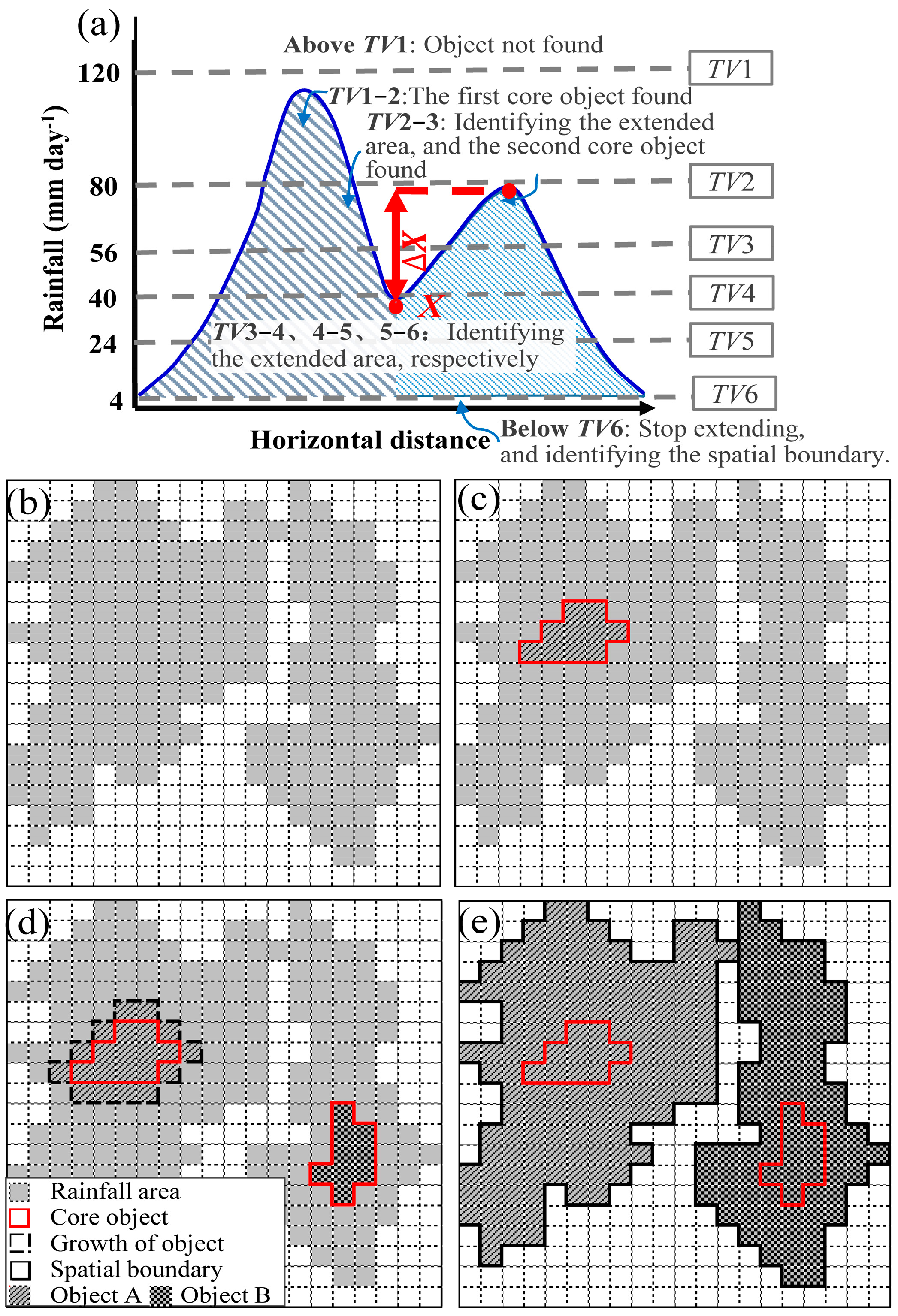
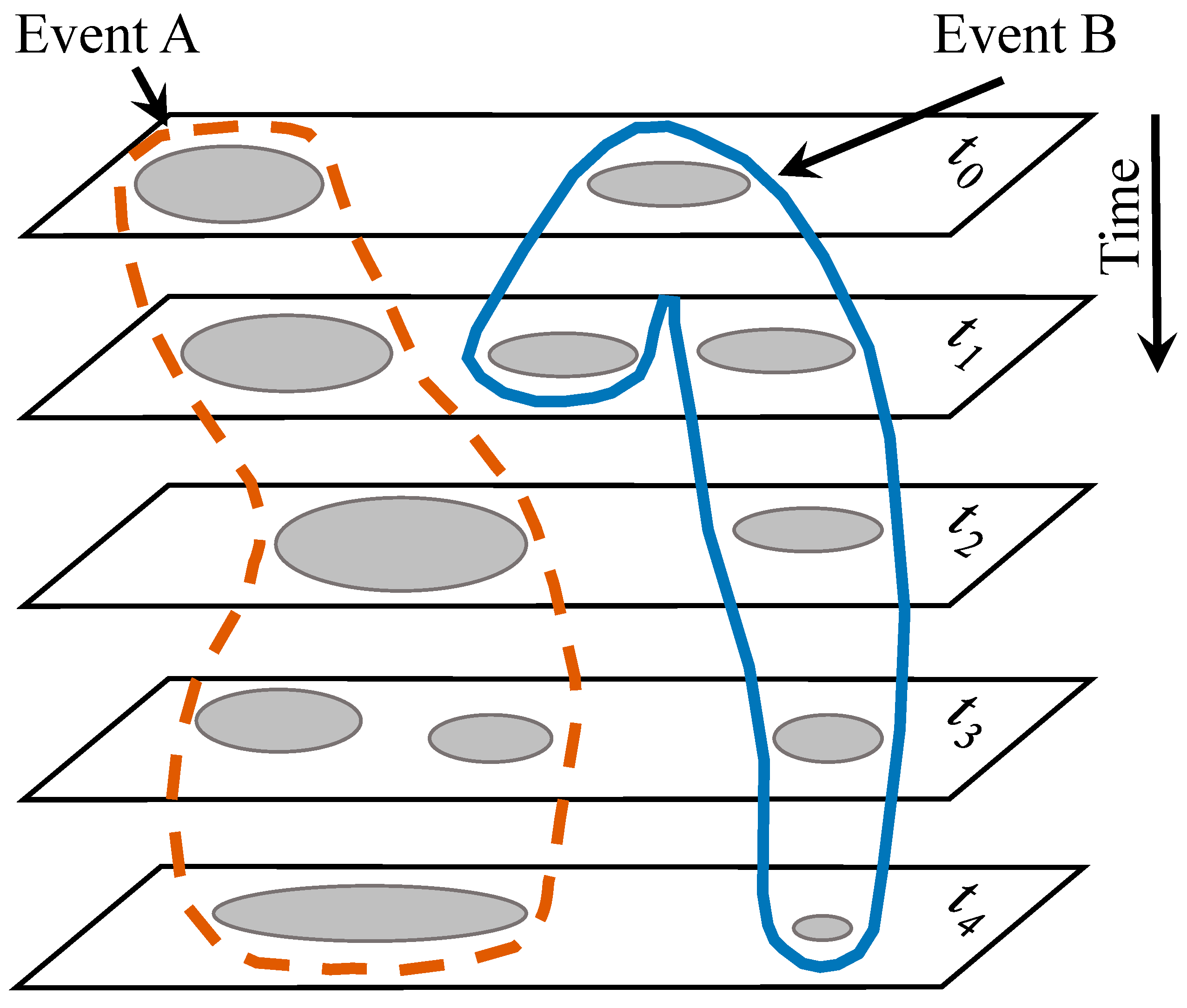
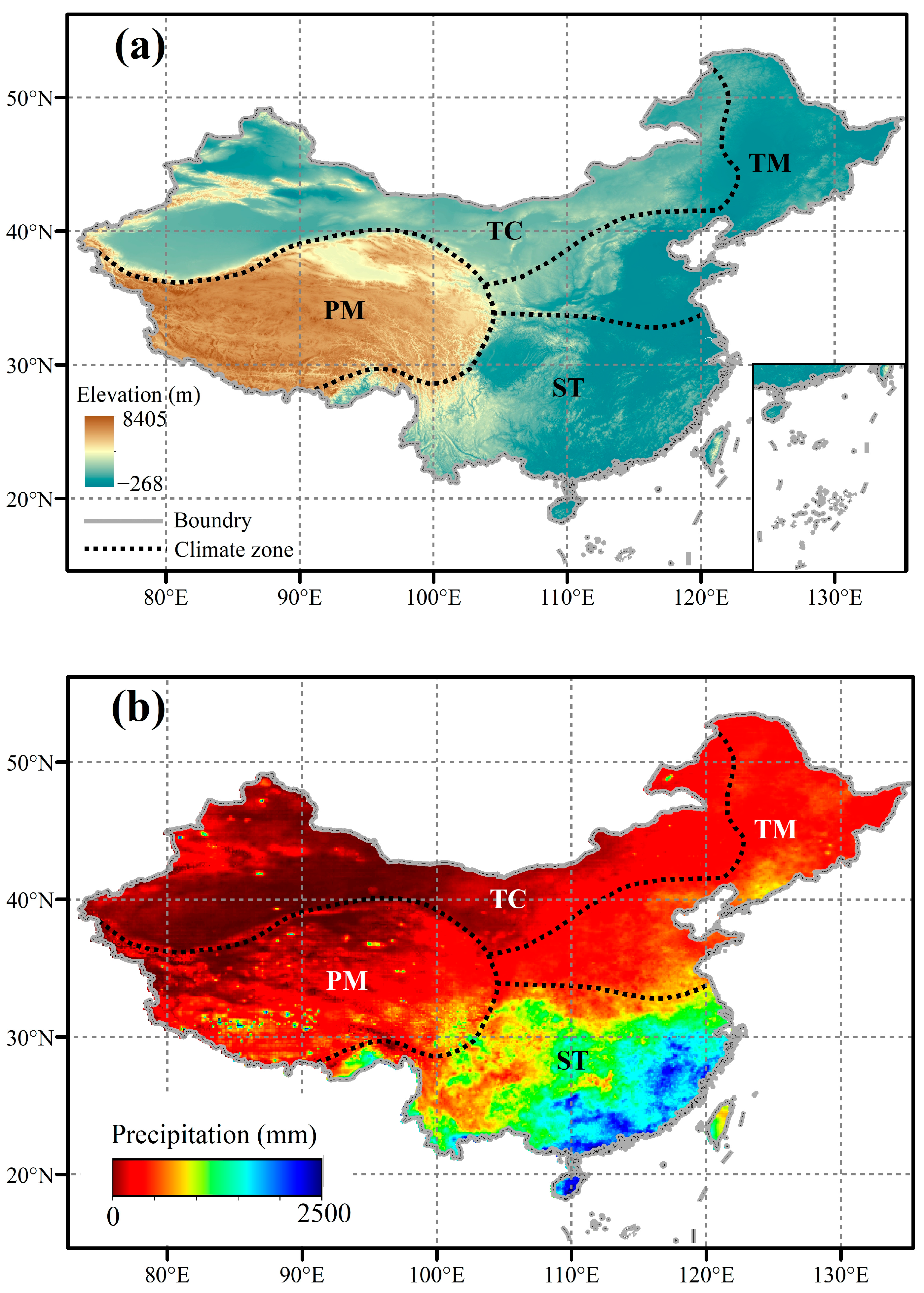
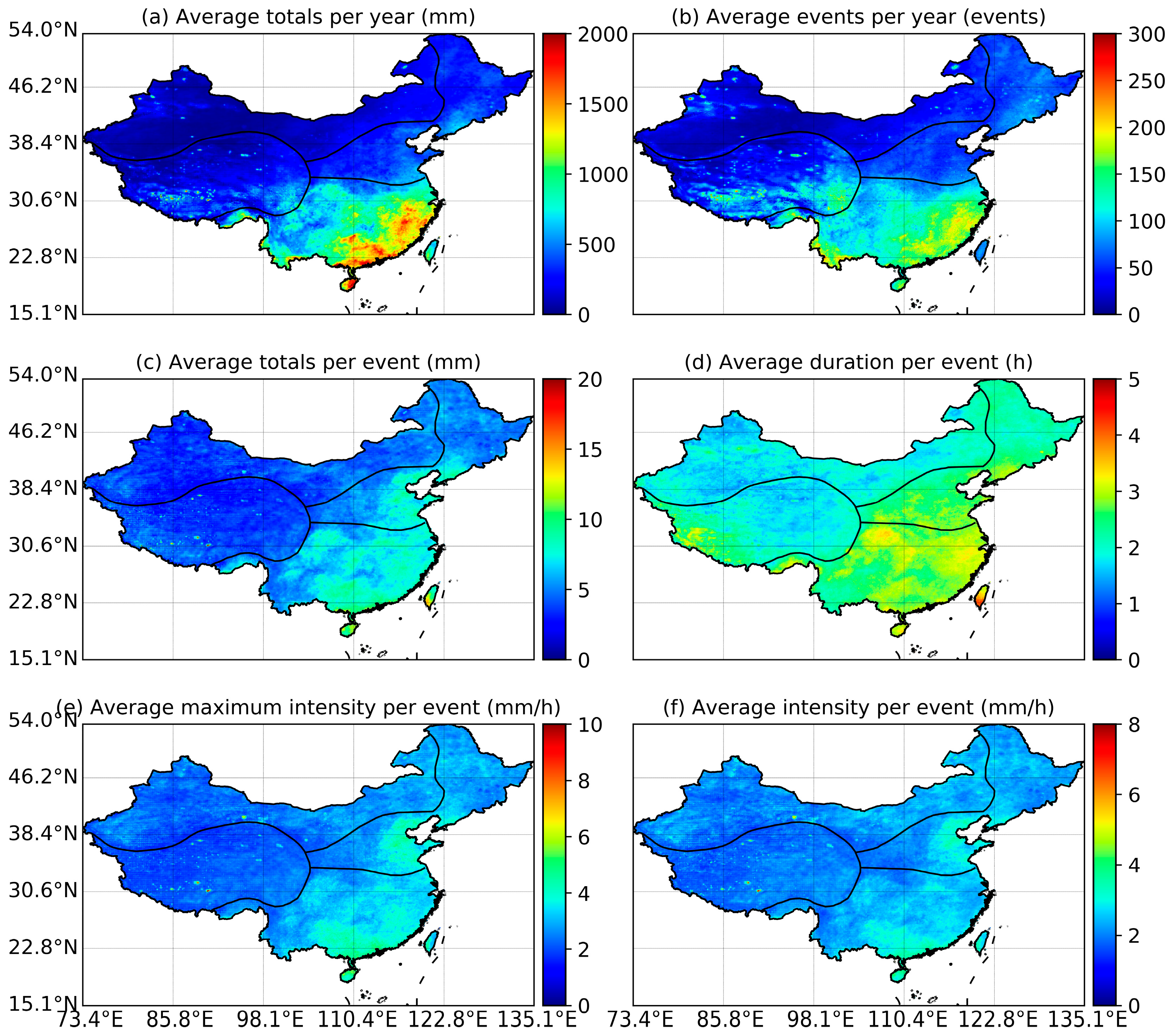


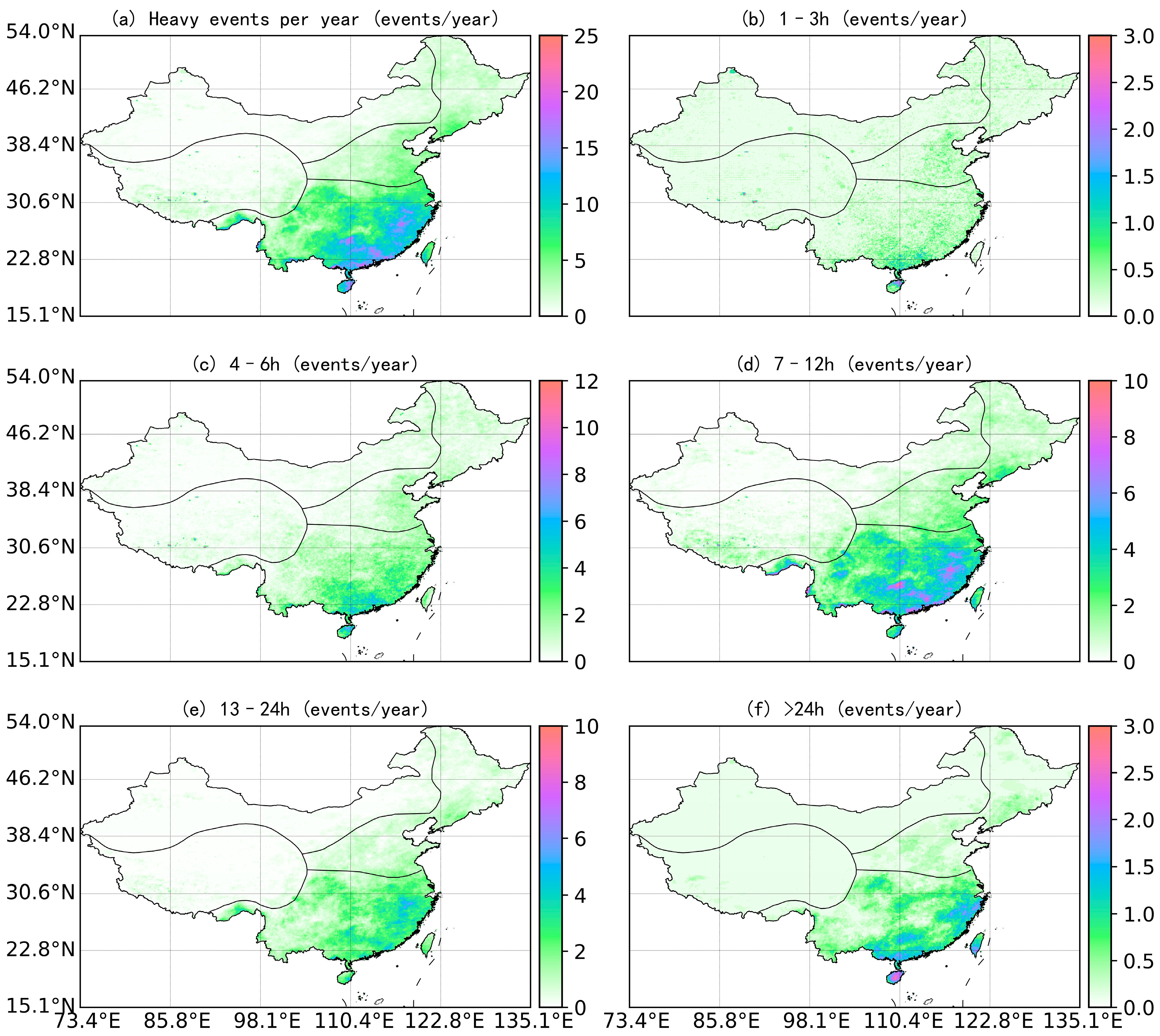
Disclaimer/Publisher’s Note: The statements, opinions and data contained in all publications are solely those of the individual author(s) and contributor(s) and not of MDPI and/or the editor(s). MDPI and/or the editor(s) disclaim responsibility for any injury to people or property resulting from any ideas, methods, instructions or products referred to in the content. |
© 2024 by the authors. Licensee MDPI, Basel, Switzerland. This article is an open access article distributed under the terms and conditions of the Creative Commons Attribution (CC BY) license (https://creativecommons.org/licenses/by/4.0/).
Share and Cite
Zhu, Z.; Peng, C.; Li, X.; Zhang, R.; Dai, X.; Jiang, B.; Chen, J. Remote Sensing-Based Analysis of Precipitation Events: Spatiotemporal Characterization across China. Water 2024, 16, 2345. https://doi.org/10.3390/w16162345
Zhu Z, Peng C, Li X, Zhang R, Dai X, Jiang B, Chen J. Remote Sensing-Based Analysis of Precipitation Events: Spatiotemporal Characterization across China. Water. 2024; 16(16):2345. https://doi.org/10.3390/w16162345
Chicago/Turabian StyleZhu, Zhihua, Chutong Peng, Xue Li, Ruihao Zhang, Xuejun Dai, Baolin Jiang, and Jinxing Chen. 2024. "Remote Sensing-Based Analysis of Precipitation Events: Spatiotemporal Characterization across China" Water 16, no. 16: 2345. https://doi.org/10.3390/w16162345
APA StyleZhu, Z., Peng, C., Li, X., Zhang, R., Dai, X., Jiang, B., & Chen, J. (2024). Remote Sensing-Based Analysis of Precipitation Events: Spatiotemporal Characterization across China. Water, 16(16), 2345. https://doi.org/10.3390/w16162345




